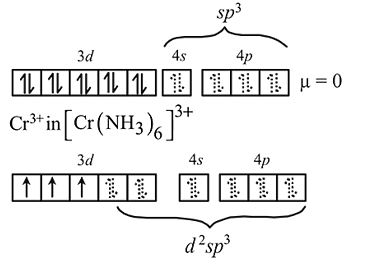Test: Werner's theory and Valence Bond Theory - JEE MCQ
20 Questions MCQ Test Chemistry for JEE Main & Advanced - Test: Werner's theory and Valence Bond Theory
 is a strong field ligand. This is due to the fact that
is a strong field ligand. This is due to the fact that
Which one of the following complexes is an outer orbital complex
Atomic nos 
Atomic nos

| 1 Crore+ students have signed up on EduRev. Have you? Download the App |
In the complex [SbF5]  hybridisation is present Geometry of the complex is
hybridisation is present Geometry of the complex is
 hybridisation is present Geometry of the complex is
hybridisation is present Geometry of the complex isAn anion solution gives a white ppt with AgNO₃ solution. The ppt. dissolves in dil. ammonia due to the formation of
Which of the following is incorrect regarding spectrochemical series?
The spin only magnetic moment of [MnBr4]x− is 5.9BM. The geometry of the complex and x respectively are
Which of the following are inner orbital complex (i.e., involving d2sp3 hybridisation) and is paramagnetic in nature?
Which of the following is organo-metallic compound?
The geometries of the ammonia complexes of Ni2+, Pt2+ and Zn2+ and  , respectively, are
, respectively, are
[NiCl2{P(C2H5)2(C6H5)}2] exhibits temperature dependent magnetic behaviour (paramagnetic/diamagnetic). The coordination geometries of Ni2+ in the paramagnetic and diamagnetic states are respectively
Which of the following complex compound(s) is/are paramagnetic and low spin?
(I) K₃[Fe(CN)₆]
(II) [Ni(CO)₄]⁰
(III) [Cr(NH₃)₆]³⁺
(IV) [Mn(CN)₆]⁴⁻
Choose the correct code:
An aqueous solution of titanium chloride, when subjected to magnetic measurement, measured zero magnetic moment. Assuming the octahedral complex in aqueous solution, the formulae of the complex is:
Which of the following statement is not true for the reaction given below?
[Cu(H2O)4]²⁺ + 4NH3 ⇌ [Cu(NH3)4]²⁺ + 4H2O
Atomic number of Cr, Fe and Co are 24, 26 and 27 respectively. Which of the following inner orbital octahedral complexes are paramagnetic?
Which of the following statements is incorrect?
An octahedral complex of CO3+ is diamagnetic. The hybridisation involved in the formation of the complex is:
The correct statement about the magnetic properties of [Fe(CN)₆]³⁻ and [FeF₆]³⁻ is:
(Z = 26):
Nickel (Z = 28) combines with a uninegative monodentate ligand to form a diamagnetic complex [NiX4]2-. The hybridization involved and the number of unpaired electrons present in the complex is respectively:
Prussian blue is a deep blue pigment containing Fe2+, Fe3+ and CN- ions. It has the formula Fe7(CN)18. How many Fe2+ and Fe3+ ions are there per formula unit?
|
352 videos|596 docs|309 tests
|
|
352 videos|596 docs|309 tests
|


 bond from pseudohalide to the metal and
bond from pseudohalide to the metal and  bond (from the metal to pseudohalide).
bond (from the metal to pseudohalide). has
has  hybridization and shows square pyramidal geometry
hybridization and shows square pyramidal geometry
 B. M.
B. M.
 will have five unpaired electrons so
will have five unpaired electrons so  will be in +2 state with
will be in +2 state with  being weak- field ligands.
being weak- field ligands. for
for 




 low spin complex μ = 1.732BM Ni in [Ni(CO)4]
low spin complex μ = 1.732BM Ni in [Ni(CO)4]
 low and high spin complex is applicable for d4 to d7 configuration
low and high spin complex is applicable for d4 to d7 configuration in
in 

 low spin complex μ = 1.732BM
low spin complex μ = 1.732BM

 is
is is square planar.
is square planar.

















